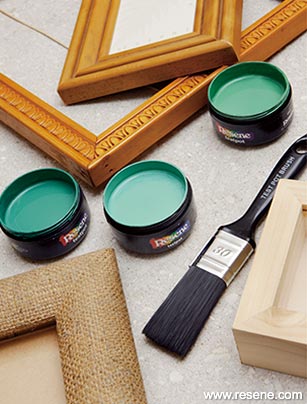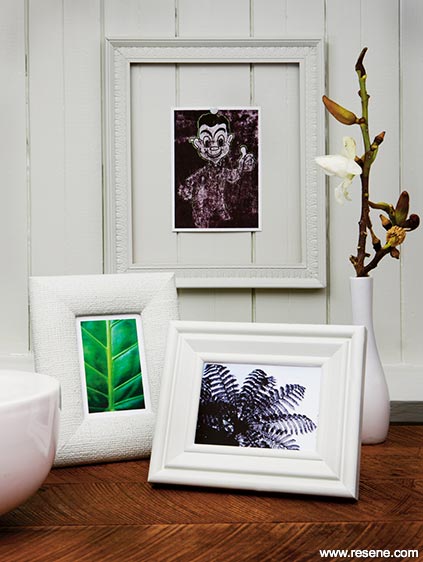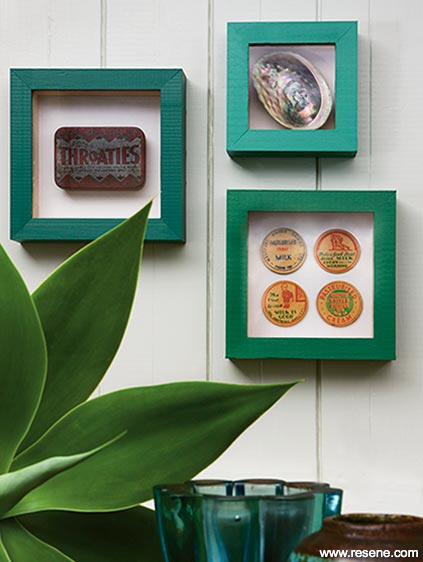From Habitat magazine - issue 09
Grab some Resene testpots, a selection of old and new frames, and get painting to create a co-ordinated look for your precious photographs and mementoes.

Resene testpots of Resene Secrets, Resene Green Room, Resene Alfresco, Resene Push Play for the green frames. And Resene Quarter Tasman and Resene Alabaster for the grey/white frames.
A selection of frames – we found two old wooden frames and a hessian-covered frame from the local second-hand shop, a $5 frame from the bargain bin at Flying Saucers and large and small wooden memory box frames from Spotlight.
Small paint brushes.
Remove any glass and backing sheet from within the frame before you paint. For heavily textured frames, it may help to use Resene Acrylic Undercoat as a first coat to achieve good coverage and to allow the true colour of the topcoat to show.


Once you have decorated your frames, it’s time to decide how best to fill them. If that is with photographs, the world of photo printing is easier than ever before. You can use an online photo printing company, use booths at the local photo kiosk or hand over your camera’s memory card to the staff, or you can be completely independent and print at home.
There’s no doubt being able to print your own photos is terribly satisfying, which is why in recent years there has been a large array of photo capable printers come on to the market.
The newest breed is the dedicated photo printer. They tend to be small and compact, fairly cheap (from $90) but generally have limitations on paper sizes. Many will only print the standard 6 x 4-inch size and aren’t able to handle text. A plus with these machines, however, is the ability to print directly from your camera or memory card, eliminating the need to use a computer.
Most of these printers offer a colour LCD screen for previewing photos before you print them, though with some the screen is only large enough to see a thumbnail of the photo.
Extra features to look out for are auto-fix, a function that will analyse your photo and automatically make adjustments, and inbuilt CD burners that allow you to archive your photos. Always make sure you see a sample output before you buy.
If you only want one printer in your life that fulfils more than just photo printing, invest in an ink jet printer that can handle text and graphics as well as colour photos. Unlike the dedicated photo printers you will have no issues over print size.
Look out for printers which offer a high resolution. This is measured in dots per inch (dpi) and is a good indication of print quality, though certainly shouldn’t be the only consideration you use when buying. In a recent review of printers (2009), www.consumer.org.nz rated an ink jet printer (Canon’s iP4500) as the best overall printer, for its high-quality printing of photos and text, its simplicity and ease of use, its moderate price and cheapness to run. A colour photograph on the Canon costs only 24c to produce.
This is comparable to online printing companies who charge 20c-28c per photo (2009). This is cheaper than most photo kiosks, where upwards of 50c can be the norm. To find the most cost-effective printer for your needs, log on to www.consumer.org.nz (printer review) where an online comparison function allows you to check out the running costs of different printers, based on your individual printing requirements.
While laser printers are cheap to run and certainly quicker at printing than ink jets, at present the quality for photos is poor.
Even the best printer won’t deliver good results if you print on low-grade paper. Specialist photo paper is quick to dry and has a high water resistance, so no smudgy fingerprints. A high-gloss 180gsm photo paper is good for everyday snaps, while a premium satin 260gsm photo paper is going to give you superior results.
Replacing ink cartridges can be expensive. Most new ink jet printers print from at least four separate colour cartridges instead of the old tri-colour single cartridge, which means you’re only replacing the colour that has run out instead of all three.
words: Jo Gaught
pictures: Dave Whorwood
styling: Lianne Whorwood
Search habitat magazine stories
Printed copies of habitat highlights are available from late March 2024 at Resene ColorShops and resellers, while stocks last. You can view back issues of habitat magazine online.
Specifiers:
If you have an idea, project or story that you think would suit habitat, we’d love to hear from you. Please drop us an email with your details and include photos if submitting a project.
Sign up for a DIY card and Save! Australia | New Zealand